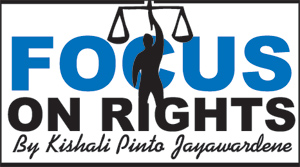The blackened and burnt hearts of our people
Sunday, June 29, 2014 The Rajapaksa Government’s attempt to marginalise recent Sinhala-Muslim violence in Aluthgama and Beruwala as being confined to a few extremist groups belies a stubborn truth. This was not a random incident. Instead it was carefully planned and meticulously executed. And as much as the incident itself gives rise to the most profound misgivings, the aftermath of the communal violence exposes an even uglier truth.
The Rajapaksa Government’s attempt to marginalise recent Sinhala-Muslim violence in Aluthgama and Beruwala as being confined to a few extremist groups belies a stubborn truth. This was not a random incident. Instead it was carefully planned and meticulously executed. And as much as the incident itself gives rise to the most profound misgivings, the aftermath of the communal violence exposes an even uglier truth. Who will rebuild the trust of communities?
Who will rebuild the trust of communities?Indeed, each statement and action of Sri Lanka’s political leadership is underlined by a contrary perversity which we ignore at our own peril. It is inevitable therefore that this government is accused of far worse than culpable inaction. This week, as Defence Secretary Gotabaya Rajapaksa asserted that the armed forces will rebuild blackened and burnt buildings, soldiers swept into the two riot-torn Southern towns even while Muslim organisations pleaded that police investigations be completed and due forensic activities be carried out before the clean-up began. This plea, however, was to no avail.
Let aside destroyed property, what of the blackened and burnt hearts of the Sinhala and Muslim communities in those stricken areas? Who will rebuild that trust? Will it be the Defence Secretary? And what moreover is the responsibility of his brother, President Mahinda Rajapaksa?
President Rajapaksa appeared outraged by the hartals engaged in by the Muslim communities in protest. Yet he still needs to emulate the heartfelt public apology tendered to his Beruwala constituents by Fisheries and Aquatic Resources Minister Rajitha Senaratne. Amusingly enough Minister Senaratne’s rejoinder, after being insulted as ‘Mohammed Rajitha’ by the Bodu Bala Sena (BBS), was that this is better than being a ‘Taliban Gnanasara.’
Magic protection of the BBS continues
But the seemingly magic protection extended by the government to BBS’s Galagoda Gnanasara Thera continued. Reportedly, even the organisation’s lower level thugs were released from custody days after the riots. The police spokesman who should seek a profitable career as a rustic comedian, meanwhile, stated during his televised media conferences that Gnanasara Thera’s inflammatory Aluthgama speech prior to the riots had not been provocative. In fact, he declared brazenly enough that there was no need to question the monk. This is incredulous talk.
But the seemingly magic protection extended by the government to BBS’s Galagoda Gnanasara Thera continued. Reportedly, even the organisation’s lower level thugs were released from custody days after the riots. The police spokesman who should seek a profitable career as a rustic comedian, meanwhile, stated during his televised media conferences that Gnanasara Thera’s inflammatory Aluthgama speech prior to the riots had not been provocative. In fact, he declared brazenly enough that there was no need to question the monk. This is incredulous talk.
Unsurprisingly such official liberality was absent in dealing with dissenters. Former minister and opposition parliamentarian Mangala Samaraweera was threatened with the Official Secrets Act (1955) when he alleged individuals in the defence establishment as being implicated in the communal violence. This archaic law is trotted out whenever the Government feels threatened. Legal activists have long been urging its repeal as it contains vague notions of what ‘official secrets’ mean. In fact, Section 6(2) of this Act provides that on a prosecution, an accused person need not be guilty of any particular act tending to show any purpose prejudicial to the safety or interests of the State. Rather, it would suffice if this is shown from his or her conduct or character. The Government’s naming of this law as a possible weapon only indicates a further chilling of free expression in an already impossibly restricted space.
Further, we were treated to an unholy drama concerning Ven. Watareke Thera threatened by the BBS and disparagingly if not unimaginatively referred to as ‘Mohammed Watareke.’ This monk was found half naked, bound with his hands behind his back and with ‘cuts’ on the Panadura bridge last week. He was thereafter arrested on preposterous charges by the police that he had ‘self-inflicted’ the wounds and (supposedly) dumped himself by the bridge. These tactics are nothing new to those familiar with the modus operandi of the police, particularly victims of police torture as extensively documented from the North to the South.
Proliferation of hypocritical gestures
In sum, Sri Lankans need to question themselves not only as to the context of the Southern violence but also as to why these post-event dramas are enacted. The absence of a professional and stoutly critical media which existed even during the worst of the ethnic conflict is stark. Social media has now taken over the public space with positive and negative consequences. But public mobilisation transcending ethnic, class and communal divides which India demonstrates through the use of social media, appears to be still far from our reach. And by this I do not mean Colombo centered conferences attended by the glitterati which we (unfortunately) excel in.
In sum, Sri Lankans need to question themselves not only as to the context of the Southern violence but also as to why these post-event dramas are enacted. The absence of a professional and stoutly critical media which existed even during the worst of the ethnic conflict is stark. Social media has now taken over the public space with positive and negative consequences. But public mobilisation transcending ethnic, class and communal divides which India demonstrates through the use of social media, appears to be still far from our reach. And by this I do not mean Colombo centered conferences attended by the glitterati which we (unfortunately) excel in.
Other spectacles attract stronger contempt. This week, an ineffective National Human Rights Commission commemorated the International Day Against Torture by holding a talkfest where the insincerity of the speakers was matched only by their politicized backgrounds. In the wake of the Commonwealth Heads of Government meeting in Colombo (2013), this Commission pledged to hold an impartial national inquiry against practices of torture; a promise it appears to have conveniently forgotten. These are hypocritical gestures.
Fated to learn hard lessons
Assuredly hypocrisy and lies predominate in every aspect of our public life. This may seem like a glaring overstatement to some. Honourable Sri Lankans certainly do live decent lives away from the public glare. But however honourable our lives may be, there is a painfully individual price to be paid when heads are turned away in the face of public injustice.
Assuredly hypocrisy and lies predominate in every aspect of our public life. This may seem like a glaring overstatement to some. Honourable Sri Lankans certainly do live decent lives away from the public glare. But however honourable our lives may be, there is a painfully individual price to be paid when heads are turned away in the face of public injustice.
Sinhala and Muslim communities living for generations without untoward incident in the South learnt this lesson very well. Ruthlessly exported communal violence exploded like a lit cigarette tossed into gasoline. Lives were lost, properties burnt and societies fractured, perhaps irreparably so.
In the absence of sustained public resistance, this communal monster exposed in all its appalling horror may be allowed to breed and gather strength to itself. If so, there is little doubt that the resulting conflagration will have the potential of reducing the thirty-year conflict between the Liberation Tigers of Tamil Eelam (LTTE) and the Sri Lankan State to a mere children’s quarrel in the playground.
